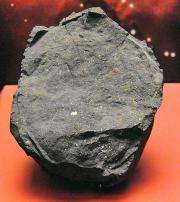February 17, 2010 report
Chemical snapshot: Murchison meteorite reveals diversity of early Solar System

(PhysOrg.com) -- New studies of a meteorite that crashed to Earth four decades ago have found it probably contains millions of organic compounds. The findings shed light on the molecular complexity that existed at or just after the birth of the Solar System.
The Murchison meteorite, a carbonaceous chondrite, fell near Murchison in Victoria in Australia in 1969, and is thought to be extremely ancient, possibly even older than the Sun, at 4.65 billion years old. It probably passed through the primordial clouds in the early Solar System, where it would have collected organic compounds. It was retrieved soon after it landed, which meant there was minimal chance of contamination, and it has been studied by scientists hoping the meteorite would yield clues about the possible origins of life on Earth. Leader of the research team, Dr Philippe Schmitt-Kopplin, said the meteorite was like a kind of fossil, and when you try to understand it, you are essentially looking back in time.
Dr Schmitt-Kopplin, from the Helmholtz Centre Munich, in Germany, said he was really excited and amazed at the complexity they found. The meteorite has been investigated many times before, but earlier studies used gas chromatography and mass spectrometry and looked for specific compounds such as amino acids.
The current study is the first non-targeted examination of the meteorite, and used high resolution technology such as NMR and ultra-high resolution mass spectrometry. The analysis took a few milligrams of crushed rock from the meteorite’s core, and then extracted the organic compounds with solvents.
Their approach is based on metabolomics, which Schmitt-Kopplin and his team uses to analyze metabolites in body fluids. The technique attempts to find as many metabolites as possible, and they used the same system on the meteorite. Specifically, the new technique is known as the Fourier transform ion cyclotron resonance/mass spectrometry (FTICR/MS), which enables the scientists to weigh ionized molecules with the accuracy of the mass of an electron.
The resolution of the analysis and the number of signals found makes the study record-breaking. Previous investigations were all targeted and used older technologies, and so the diversity was never discovered before. The results of the analysis identified about 14,000 different molecules in the meteorite, which can be combined in millions of different organic compounds. Schmitt-Kopplin said their calculations and interpolation were “very conservative”. Their findings show the nascent Solar System probably had more molecular diversity than present-day Earth.
The results of the study appear in the Proceedings of the National Academy of Sciences (PNAS) journal.
More information: High molecular diversity of extraterrestrial organic matter in Murchison meteorite revealed 40 years after its fall, Philippe Schmitt-Kopplin et al., PNAS February 16, 2010 vol. 107 no. 7 2763-2768, doi: 10.1073/pnas.0912157107
© 2010 PhysOrg.com



















